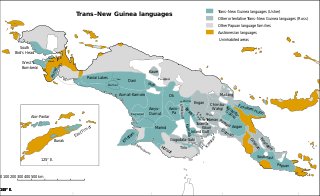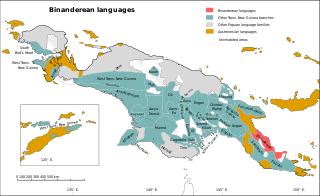Related Research Articles
The proto-human language is the hypothetical direct genetic predecessor of all the world's spoken languages.
Linguistic typology is a field of linguistics that studies and classifies languages according to their structural features to allow their comparison. Its aim is to describe and explain the structural diversity and the common properties of the world's languages. Its subdisciplines include, but are not limited to phonological typology, which deals with sound features; syntactic typology, which deals with word order and form; lexical typology, which deals with language vocabulary; and theoretical typology, which aims to explain the universal tendencies.

Trans–New Guinea (TNG) is an extensive family of Papuan languages spoken on the island of New Guinea and neighboring islands, a region corresponding to the country Papua New Guinea as well as parts of Indonesia.

The Papuan languages are the non-Austronesian languages spoken on the western Pacific island of New Guinea, as well as neighbouring islands in Indonesia, Solomon Islands, and East Timor by around 4 million people. It is a strictly geographical grouping, and does not imply a genetic relationship.
Indo-Pacific is a hypothetical language macrofamily proposed in 1971 by Joseph Greenberg and now believed to be spurious. It grouped together the Papuan languages of New Guinea and Melanesia with the languages of the Andaman Islands and, tentatively, the languages of Tasmania, both of which are remote from New Guinea. The valid cognates Greenberg found turned out to be reflexes of the less extensive Trans–New Guinea family. Recently the Kusunda language, which is generally seen as a language isolate, is also included in the Indo-Pacific proposal. Greenberg did not include "Australian" in his original 1971 proposal.
Mbula is an Austronesian language spoken by around 2,500 people on Umboi Island and Sakar Island in the Morobe Province of Papua New Guinea. Its basic word order is subject–verb–object; it has a nominative–accusative case-marking strategy.
Numbami is an Austronesian language spoken by about 200 people with ties to a single village in Morobe Province, Papua New Guinea. It is spoken in Siboma village, Paiawa ward, Morobe Rural LLG.
Yabem, or Jabêm, is an Austronesian language of Papua New Guinea.
The Wuvulu-Aua language is a language spoken on the Wuvulu and Aua Islands, and across the Manus Province of Papua New Guinea.
Abui is a non-Austronesian language of the Alor Archipelago. It is spoken in the central part of Alor Island in Eastern Indonesia, East Nusa Tenggara (NTT) province by the Abui people. The native name in the Takalelang dialect is Abui tanga which literally translates as 'mountain language'.
A coverb is a word or prefix that resembles a verb or co-operates with a verb. In languages that have the serial verb construction, coverbs are a type of word that shares features of verbs and prepositions. A coverb takes an object or complement and forms a phrase that appears in sequence with another verb phrase in accordance with the serial construction. A coverb appears to be subordinate to a main verb and fulfills a function similar to that of a preposition.
Kâte is a Papuan language spoken by about 6,000 people in the Finschhafen District of Morobe Province, Papua New Guinea. It is part of the Finisterre–Huon branch of the Trans–New Guinea language family. It was adopted for teaching and mission work among speakers of Papuan languages by the Evangelical Lutheran Church of Papua New Guinea in the early 1900s and at one time had as many as 80,000 second-language speakers.

The Madang or Madang–Adelbert Range languages are a language family of Papua New Guinea. They were classified as a branch of Trans–New Guinea by Stephen Wurm, followed by Malcolm Ross. William A. Foley concurs that it is "highly likely" that the Madang languages are part of TNG, although the pronouns, the usual basis for classification in TNG, have been "replaced" in Madang. Timothy Usher finds that Madang is closest to the Upper Yuat River languages and other families to its west, but does not for now address whether this larger group forms part of the TNG family.

The Greater Binanderean or Guhu-Oro languages are a language family spoken along the northeast coast of the Papuan Peninsula – the "Bird's Tail" of New Guinea – and appear to be a recent expansion from the north. They were classified as a branch of the Trans–New Guinea languages by Stephen Wurm (1975) and Malcolm Ross (2005), but removed by Timothy Usher (2020). The Binandere family proper is transparently valid; Ross connected it to the Guhu-Semane isolate based on pronominal evidence, and this has been confirmed by Smallhorn (2011). Proto-Binanderean has been reconstructed in Smallhorn (2011).
Maybrat is a Papuan language spoken in the central parts of the Bird's Head Peninsula in the Indonesian province of Southwest Papua.
Nabak is a Papuan language spoken by around 16,000 people in the Morobe Province located in the western Huon Peninsula of Papua New Guinea. Nabak follows the SOV typology. It uses Latin script in its written form.
Kalam is a Kalam language of Papua New Guinea. It is closely related to Kobon, and shares many of the features of that language. Kalam is spoken in Middle Ramu District of Madang Province and in Mount Hagen District of Western Highlands Province.
Kunimaipa is a Papuan language of New Guinea. The varieties are divergent, on the verge of being distinct languages, and have separate literary traditions.
Safeyoka, or Ampale, is an Angan language of Papua New Guinea. Other names of this language include Ambari, Ampeeli, Ampeeli-Wojokeso, and Ampele. According to a 1980 census, there were around 2,390 native speakers. Commonly known as Ampale, the dialect is called Wojokeso. Speakers of Ampale range from the Waffa River to the Banir River, which is located in the northern part of Papua New Guinea. The Wojokeso dialect is spoken by people who live in five villages where multiple districts, the Kaiapit, Mumeng and Menyama come together in the Morobe Province.

Baluan-Pam is an Oceanic language of Manus Province, Papua New Guinea. It is spoken on Baluan Island and on nearby Pam Island. The number of speakers, according to the latest estimate based on the 2000 Census, is 2,000. Speakers on Baluan Island prefer to refer to their language with its native name Paluai.
References
- 1 2 3 4 Angaatiha at Ethnologue (25th ed., 2022)

- ↑ "Documentation for ISO 639 identifier: agm".
- ↑ Matthew S. Dryer. 2013. Order of Subject, Object and Verb. In: Dryer, Matthew S. & Haspelmath, Martin (eds.) The World Atlas of Language Structures Online. Leipzig: Max Planck Institute for Evolutionary Anthropology. (Available online at http://wals.info/chapter/81, Accessed on 2018-03-09.)
- 1 2 Grimes, Joseph Evans (1975). The Thread of Discourse. Walter de Gruyter. p. 40. ISBN 9789027931641.
- ↑ Merritt Ruhlen. "A Guide to the World's Languages, Vol. 1: Classification", 1987, str. 301–378
- ↑ "Angaatiha Language Sample".